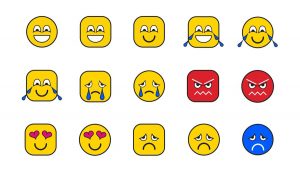
On World Emoji Day (Wednesday 17th July), global socially-led creative agency We Are Social and the Royal National Institute of Blind People (RNIB) have announced a mission to make emojis – the universal online language – more accessible to blind and partially sighted people.
In the UK, there are currently more than two million people living with sight loss and they often struggle to use emojis due to their complex detail and the user interface when selecting them.
So, starting with a selection of the top ten most used emojis in 2018, We Are Social and RNIB kicked off the project with a one day workshop which helped both organisations understand the design elements of emojis and how they appear to those who are visually impaired.
The key issues for blind and partially sighted people that the group identified were:
- People struggle to differentiate emojis due to the level of detail – such as shading, colour and contrast, as well as the subtle differences in the facial expressions;
- People have difficulty identifying emojis when three or more are used in a row in a social post or message;
- The user experience of selecting an emoji (even with the help of a text reader) makes it difficult to sort through and select the desired emoji, as the emojis are uncategorised and grouped close together.
As a result of the session, the joint creative teams, which included a participant who is partially sighted, looked to tackle these issues by designing a prototype for eight of the most-used emojis. The new designs – currently undergoing further testing – focus on aspects such as a more prominent eye shape, as eyes were found to be a particularly important factor in communicating the emotion; as well as a more distinct outline.
The teams have also started developing a style guide to help address key issues such as colour, contrast and shading as well as a set of guidelines to help brands understand how to use emojis in a way which is more visible to blind and partially sighted people. This will be expanded upon as the project progresses.

The newly designed set of new emojis will be developed further with a view to evolving and improving the end designs based on user feedback. The first set of emojis will initially be made available to users as a Sticker pack, once testing has been completed.
Alistair Campbell, executive creative director, We Are Social, said: “Emojis have become the world’s favourite language, but for a significant minority they are another way that they’re excluded from everyday life. While it may not seem like a big deal, imagine being the teenager that’s not able to communicate the same way as your peers and how that must feel. It’s easy to overlook that, for many people living in the UK, this ‘inclusive’ language is actually the opposite. It’s been a real journey of discovery to see how complex design can act as a barrier for visually impaired people, and to start to make the first step in creating a more universally inclusive set of emojis for everyone. We hope that in working closely with RNIB, we’ll be able to bring the fun world of emojis to a whole new audience and, in the long-run, would love to see more accessible emojis adopted as standard by Unicode.”
Martin Wingfield, Head of Brand, RNIB, added: “Emojis are a universal language that are enjoyed by many but are often designed and used in a way that means that they are not accessible for blind and partially sighted people. Emoji users can make them more inclusive and easier to understand for people with sight loss by not using similar emojis together, leaving spaces between them, and placing them at the end and not in the middle of a sentence. Also, placing all information before using an emoji helps to keep blind and partially sighted people in the conversation.”
To track the progress of this ongoing project, please visit here.
Source: We Are Social

You must be logged in to post a comment Login